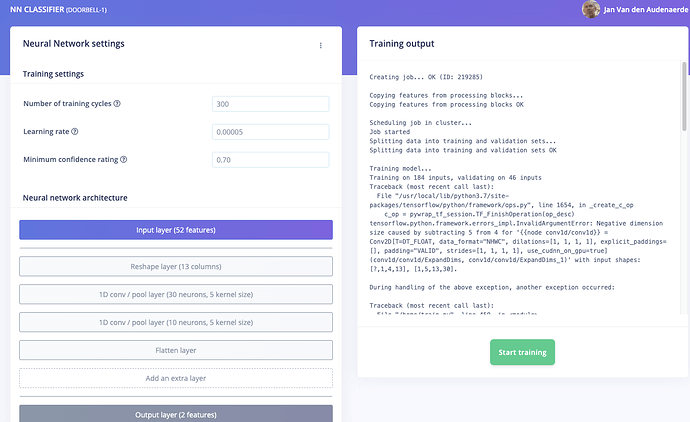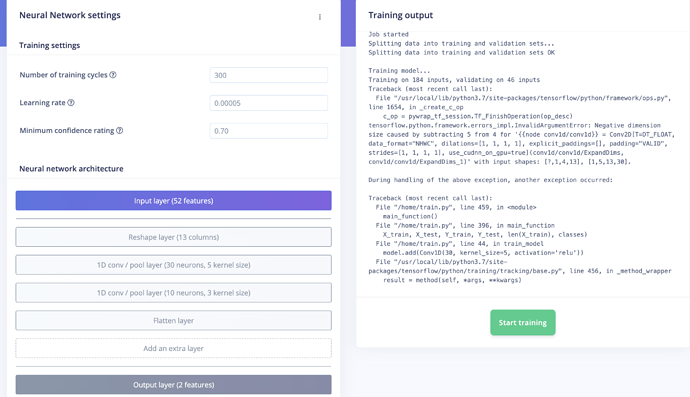When starting training of my Neural Network it is reporting the following error:
Creating job... OK (ID: 219285)
Copying features from processing blocks...
Copying features from processing blocks OK
Scheduling job in cluster...
Job started
Splitting data into training and validation sets...
Splitting data into training and validation sets OK
Training model...
Training on 184 inputs, validating on 46 inputs
Traceback (most recent call last):
File "/usr/local/lib/python3.7/site-packages/tensorflow/python/framework/ops.py", line 1654, in _create_c_op
c_op = pywrap_tf_session.TF_FinishOperation(op_desc)
tensorflow.python.framework.errors_impl.InvalidArgumentError: Negative dimension size caused by subtracting 5 from 4 for '{{node conv1d/conv1d}} = Conv2D[T=DT_FLOAT, data_format="NHWC", dilations=[1, 1, 1, 1], explicit_paddings=[], padding="VALID", strides=[1, 1, 1, 1], use_cudnn_on_gpu=true](conv1d/conv1d/ExpandDims, conv1d/conv1d/ExpandDims_1)' with input shapes: [?,1,4,13], [1,5,13,30].
During handling of the above exception, another exception occurred:
Traceback (most recent call last):
File "/home/train.py", line 459, in <module>
main_function()
File "/home/train.py", line 396, in main_function
X_train, X_test, Y_train, Y_test, len(X_train), classes)
File "/home/train.py", line 44, in train_model
model.add(Conv1D(30, kernel_size=5, activation='relu'))
File "/usr/local/lib/python3.7/site-packages/tensorflow/python/training/tracking/base.py", line 456, in _method_wrapper
result = method(self, *args, **kwargs)
File "/usr/local/lib/python3.7/site-packages/tensorflow/python/keras/engine/sequential.py", line 213, in add
output_tensor = layer(self.outputs[0])
File "/usr/local/lib/python3.7/site-packages/tensorflow/python/keras/engine/base_layer.py", line 922, in __call__
outputs = call_fn(cast_inputs, *args, **kwargs)
File "/usr/local/lib/python3.7/site-packages/tensorflow/python/keras/layers/convolutional.py", line 207, in call
outputs = self._convolution_op(inputs, self.kernel)
File "/usr/local/lib/python3.7/site-packages/tensorflow/python/ops/nn_ops.py", line 1106, in __call__
return self.conv_op(inp, filter)
File "/usr/local/lib/python3.7/site-packages/tensorflow/python/ops/nn_ops.py", line 638, in __call__
return self.call(inp, filter)
File "/usr/local/lib/python3.7/site-packages/tensorflow/python/ops/nn_ops.py", line 237, in __call__
name=self.name)
File "/usr/local/lib/python3.7/site-packages/tensorflow/python/ops/nn_ops.py", line 226, in _conv1d
name=name)
File "/usr/local/lib/python3.7/site-packages/tensorflow/python/util/deprecation.py", line 574, in new_func
return func(*args, **kwargs)
File "/usr/local/lib/python3.7/site-packages/tensorflow/python/util/deprecation.py", line 574, in new_func
return func(*args, **kwargs)
File "/usr/local/lib/python3.7/site-packages/tensorflow/python/ops/nn_ops.py", line 1663, in conv1d
name=name)
File "/usr/local/lib/python3.7/site-packages/tensorflow/python/ops/gen_nn_ops.py", line 969, in conv2d
data_format=data_format, dilations=dilations, name=name)
File "/usr/local/lib/python3.7/site-packages/tensorflow/python/framework/op_def_library.py", line 744, in _apply_op_helper
attrs=attr_protos, op_def=op_def)
File "/usr/local/lib/python3.7/site-packages/tensorflow/python/framework/func_graph.py", line 595, in _create_op_internal
compute_device)
File "/usr/local/lib/python3.7/site-packages/tensorflow/python/framework/ops.py", line 3327, in _create_op_internal
op_def=op_def)
File "/usr/local/lib/python3.7/site-packages/tensorflow/python/framework/ops.py", line 1817, in __init__
control_input_ops, op_def)
File "/usr/local/lib/python3.7/site-packages/tensorflow/python/framework/ops.py", line 1657, in _create_c_op
raise ValueError(str(e))
ValueError: Negative dimension size caused by subtracting 5 from 4 for '{{node conv1d/conv1d}} = Conv2D[T=DT_FLOAT, data_format="NHWC", dilations=[1, 1, 1, 1], explicit_paddings=[], padding="VALID", strides=[1, 1, 1, 1], use_cudnn_on_gpu=true](conv1d/conv1d/ExpandDims, conv1d/conv1d/ExpandDims_1)' with input shapes: [?,1,4,13], [1,5,13,30].
Application exited with code 1 (Error)
Job failed (see above)
Here a screenshot of the same error:
Here a screenshot of the generated features (MFCC) that are used as input for the neural network:



